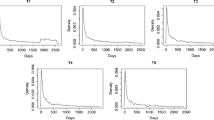Abstract
Increasing demand on hospital resources by an ageing population is impacting significantly on the number of beds available and, in turn, the length of time that elderly patients must wait for a bed before being admitted to hospital. This research presents a new methodology that models patient pathways and allows the accurate prediction of patient length of stay in hospital, using a phase-type survival tree to cluster patients based on their covariates and length of stay in hospital. A type of Markov model, called the conditional Coxian phase-type distribution is then implemented, with the probability density function for the time spent at a particular stage of care, for example, the first community discharge, conditioned on the length of stay experienced at the previous stage, namely the initial hospital admission. This component of the methodology is subsequently applied to each cohort of patients over a number of hospital and community stages in order to build up the profile of patient readmissions and associated timescales for each cohort. It is then possible to invert the methodology, so that the length of stay for an observation representing a new patient admission may be estimated at each stage of care, based on the assigned cohort at the initial hospital stage. This approach provides hospital managers with an accurate understanding of the rates with which different groups of patients move between hospital and community care, which may be used to reduce the negative effects of bed-blocking and the premature discharge of patients without a required period of convalescence. This has the benefit of assisting hospital managers with the effective allocation of vital healthcare resources. The approach presented is different to previous research in that it allows the inclusion of patient covariate information into the methodology describing patient transitions between hospital and community care stages in an aggregate Markov process. A data set containing hospital readmission data for elderly patients from the Abruzzo region of Italy is used as a case study in the application of the presented methodology.




Similar content being viewed by others
References
Parry A (1996) An age-related service revisited. In: Go with the Flow: A system approach to healthcare planning, pp 127–130
El-Darzi E, Vasilakis C, Chaussalet TJ, Millard PH (1998) A simulation modelling approach to evaluating length of stay, occupancy, emptiness and bed blocking in a hospital geriatric department. Health Care Manag Sci 1 (2):143–149
Marshall AH, McClean S (2003) Conditional phase-type distributions for modelling patient length of stay in hospital. International Transactions in Operational Research
Marshall AH, Vasilakis C, El-Darzi E (2005) Length of stay-based patient flow-models: recent developments and future directions. Health Care Manag Sci 8(3):213–220
Maguire PA, Taylor IC, Stout RW (1986) Elderly patients in acute medical wards: factors predicting length of stay in hospital. Br Med J (Clin Res Ed) 292(6530):1251–1253
Gordon AS, Marshall AH, Cairns KJ (2016) A conditional approach for modelling patient readmissions to hospital using a mixture of Coxian phase-type distributions incorporating Bayes’ theorem. Stat Med 35(21):3810–3826
Garg L, McClean S, Meenan B, Milllard PH (2011) Phase-type survival trees and mixed distribution survival trees for clustering patients’ hospital length of stay. Informatica 22(1): 57–72
Ross SM (2006) Stochastic processes. Wiley, New York
Neuts M (1981) Matrix-geometric solutions in stochastic models: an algorithmic approach. John Hopkins University Press, Baltimore
Marshall AH, McClean SI (2004) Using Coxian phase-type distributions to identify patient characteristics for duration of stay in hospital. Health Care Manag Sci 7(4):285–289
Marshall AH, Mitchell H, Zenga M (2014) Modelling the length of stay of geriatric patients in Emilia-Romagna hospitals using coxian Phase-Type distributions with covariates. Adv Latent Variables 127–139
Payne K, Marshall AH, Cairns KJ (2011) Investigating the efficiency of fitting Coxian phase-type distributions to health-care data. IMA J Manag Math
Faddy MJ (1998) On inferring the number of phases in a Coxian phase-type distribution. Stoch Model 14(1-2):407–417
McClean SI, Garg L, Barton M, Fullerton K (2010) Using mixed phase-type distributions to model patient pathways. In: 23rd IEEE international symposium on computer-based medical systems, pp 172–177
Gordon AS, Marshall AH, Zenga M (2016) A discrete conditional phase-type model utilising a survival tree for the identification of elderly patient cohorts and their subsequent prediction of length of stay in hospital. In: 29th IEEE internations symposium on computer-based medical systems, pp 259–264
Akaike H (1974) A new look at the statistical model identification. IEEE Trans Autom Control
Ventura C (2014) Models for predicting readmissions in heart failure patients: a comparison between Lombardia and England, PhD thesis
Ypma T (1995) Historical development of the Newton-Raphson method. SIAM Rev 37(4):531–551
Xie H, Chaussalet TJ, Millard PH (2005) A continuous time Markov model for the length of stay of elderly people in institu- tional long–term care. J R Stat Soc A Stat Soc 168.1:51–61
Acknowledgments
The authors would like to thank the Ministry of Health in Italy for providing the data used in the study and Dr. Ken Fullerton for his invaluable input and insight.
Author information
Authors and Affiliations
Corresponding author
Rights and permissions
About this article
Cite this article
Gordon, A.S., Marshall, A.H. & Zenga, M. Predicting elderly patient length of stay in hospital and community care using a series of conditional Coxian phase-type distributions, further conditioned on a survival tree. Health Care Manag Sci 21, 269–280 (2018). https://doi.org/10.1007/s10729-017-9411-9
Received:
Accepted:
Published:
Issue Date:
DOI: https://doi.org/10.1007/s10729-017-9411-9




